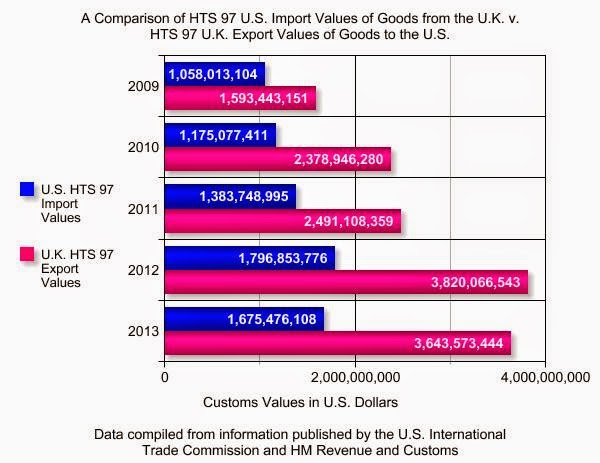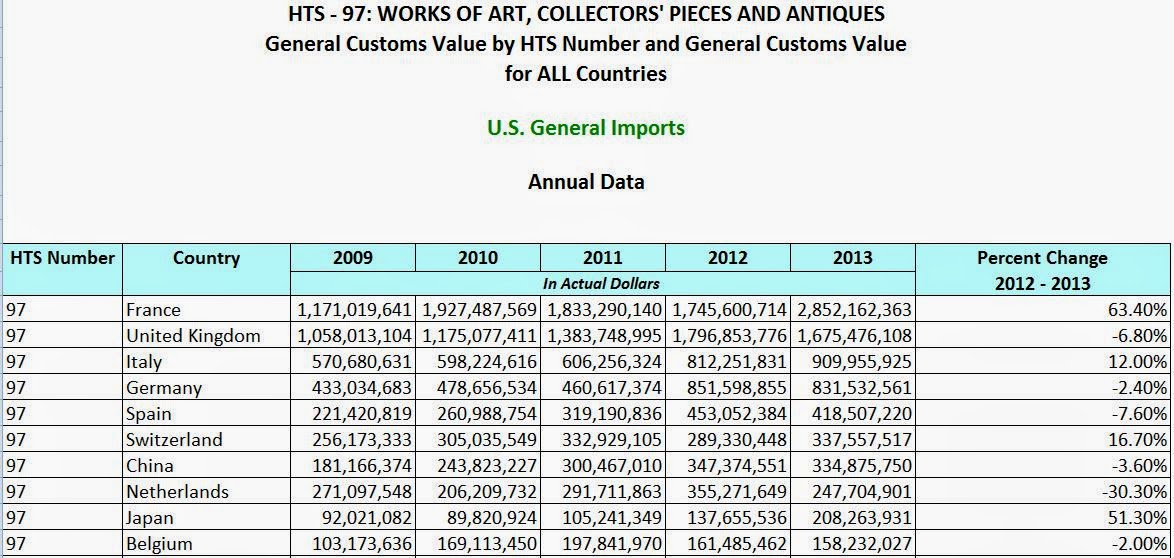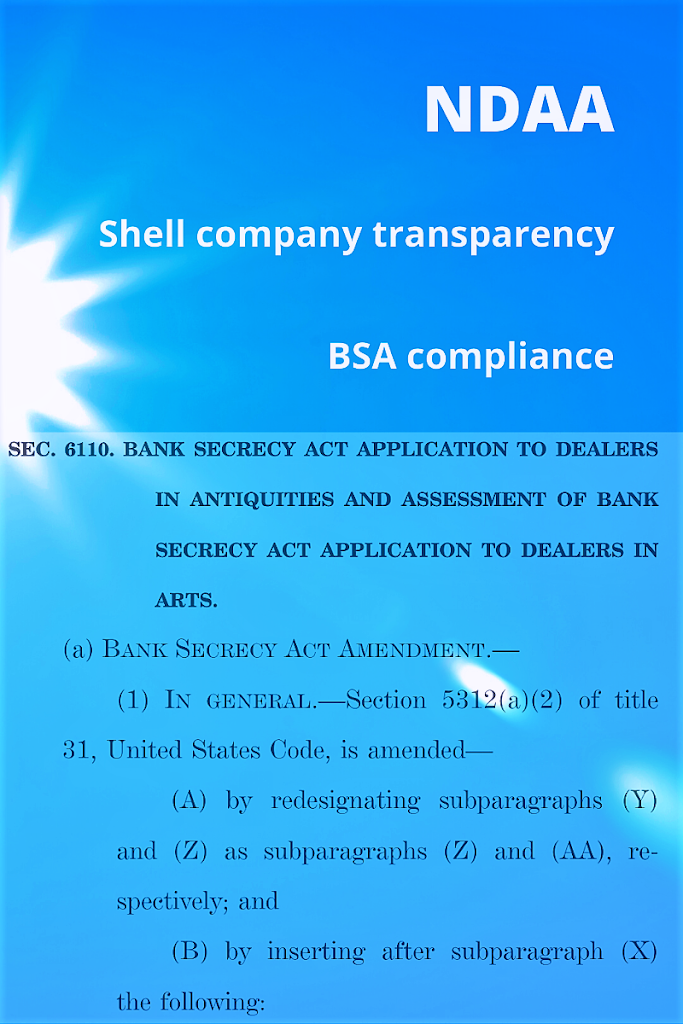The reported export values of art and antiquities shipped from the United Kingdom to the United States over the last five years do not match the reported U.S. import values for the same classified commodities. In fact, the published values are substantially different, amounting to roughly $6.8 billion in missing value over the last five years.
The art and antiquities trade between the United States and the United Kingdom can be measured by examining public data produced by the U.S. International Trade Commission and by HM Revenue & Customs. CHL recently looked at the 2013 trade in works of art, collectors pieces, and antiques exported from the U.K and imported into the U.S., asking why the reported values differed by approximately $2 billion. The trade data reviewed here compares export and import values over a five year period, from 2009 through 2013.
The commodities examined are classified by Harmonized Tariff Schedule (HTS) code 97, covering works of art, collectors’ pieces and antiques. HTS 97 specifically comprises paintings, drawings, engravings, prints, lithographs, sculptures, statuary, and stamps. It also includes collectors’ pieces and collections of zoological, botanical, mineralogical, anatomical, historical, archaeological, and paleontological materials. Numismatics fall under the definition as well. So too do antiques over 100 years old.
The chart below graphically displays the gap between export values published by the U.K. and the import values published by the U.S. for all goods each country classifies under HTS 97. The value differences are listed in billions of U.S. dollars.
One can easily see the striking value differences over the last five years. In 2010, 2012 and 2013 the gaps in U.K.-U.S. customs values measure at least 50% or more for each of those years. Also noteworthy is the pattern whereby the reported values of U.K. HTS 97 exports are consistently higher than the reported values of U.S. HTS 97 imports.
The actual value gaps–the differences between the reported U.K. HTS 97 export values and the reported U.S. HTS 97 import values–from 2009 through 2013, and their percentage differences, are outlined in the table below.
Value Gap Percent Difference
2010 $1,203,868,869 50.6%
2011 $1,107,359,364 44.5%
2012 $2,023,212,767 53.0%
2013 $1,968,097,336 54.0%
Given that the reported customs values of American HTS 97 imports have been less than–and even more than half as much as–the reported values of British HTS 97 exports, and given that billions of dollars appear unaccounted for, the published trade data should prompt both American and British customs authorities to investigate the reasons behind the export-import rift.
______________________________________
Copyright notice: Although the data presented here is sourced from publicly available information, it has been carefully selected, coordinated, arranged, and analyzed so that it is subject to copyright as a compilation by CHL. The publication, retransmission, or broadcast of this compiled data is strictly prohibited without CHL’s express consent.
Notes about the data:
The U.S. and the U.K. each define what is covered under HTS 97 in documents found here and here, respectively. They both title HTS 97 as “Works of Art, Collectors’ Pieces and Antiques,” and both nations supply substantially the same definitions and exclusions.
The U.S. specifically notes that HTS 97 “covers not only original sculpture made by the sculptor, but also the first 12 castings, replicas or reproductions made from a sculptor’s original work or model, by the sculptor himself or by another artist, with or without a change in scale and whether or not the sculptor is alive at the time the castings, replicas or reproductions are completed.”
The U.K. clarifies that collectors’ motor vehicles of historical or ethnographic interest, which are in their original condition, at least 30 years old, and no longer in production are goods classified by HTS 97.
The U.K. defines HTS 97 goods as:
Paintings, drawings and pastels, executed entirely by hand, other than drawings of heading 4906 and other than hand-painted or hand-decorated manufactured articles; collages and similar decorative plaques.
Original engravings, prints and lithographs.
Original sculptures and statuary, in any material.
Postage or revenue stamps, stamp-postmarks, first-day covers, postal stationery (stamped paper), and the like, used or unused, other than those of heading 4907.
Collections and collectors’ pieces of zoological, botanical, mineralogical, anatomical, historical, archaeological, palaeontological, ethnographic or numismatic interest.
Antiques of an age exceeding 100 years.
The U.S. defines HTS 97 goods as:
Paintings, drawings and pastels,executed entirely by hand, other than drawingsof heading 4906 and other than hand-painted or hand-decorated manufactured articles; collages and similar decorative plaques; all the foregoing framedor not framed.
Original engravings, prints and lithographs, framed or not framed.
Original sculptures and statuary, in any material.
Postageor revenue stamps,stamp-postmarks, first- day covers, postalstationery (stamped paper) and the like, used, or if unused not of currentor new issue in the countryto which they are destined.Collections and collectors’ piecesof zoological, botanical,mineralogical, anatomical, historical, archeological, paleontological, ethnographic or numismatic interest.Antiques of an age exceeding one hundred years.
Both nations carry this same exclusion:
1. This chapter does not cover:
(a) unused postage or revenue stamps, postal stationery (stamped paper) or the like, of heading 4907;
(b) theatrical scenery, studio back-cloths or the like, of painted canvas (heading 5907) except if they may be classified in heading 9706; or
(c) pearls, natural or cultured, or precious or semi-precious stones (headings 7101 to 7103).
2. For the purposes of heading 9702, the expression ‘original engravings, prints and lithographs’ means impressions produced directly, in black and white or in colour, of one or of several plates wholly executed by hand by the artist, irrespective of the process or of the material employed by him, but not including any mechanical or photomechanical process.
3. Heading 9703 does not apply to mass-produced reproductions or works of conventional craftsmanship of a commercial character, even if these articles are designed or created by artists.
4. (A) Subject to Notes 1 to 3 above, articles of this chapter are to be classified in this chapter and not in any other chapter of the nomenclature.
(B) Heading 9706 does not apply to articles of the preceding headings of this chapter.
5. Frames around paintings, drawings, pastels, collages or similar decorative plaques, engravings, prints or lithographs are to be classified with those articles, provided they are of a kind and of a value normal to those articles. Frames which are not of a kind or of a value normal to the articles referred to in this note are to be classified separately.
The HTS 97 exports from the U.K. to the U.S., as reported by HM Revenue & Customs, are in GBP. The exchange rate as of December 31 for each year have been used to supply the currency conversion into USD
2013 2202630107 GBP = 3643573444.36 USD
2012 2362859107 GBP = 3820066543.04 USD
2011 1608179003 GBP = 2491108358.65 USD
2010 1532463711 GBP = 2378946280.15 USD
2009 982324630 GBP = 1593443150.52 USD
Update 5/14/14: A screenshot showing the actual HM Revenue & Customs export data produced in the agency’s original format. The data table clearly displays code 97, the “Export” tables, and identifies the values documenting exports to the “United States.”
HM Revenue & Customs states on its web site:
“This web site is managed by HM Revenue & Customs (HMRC) Trade Statistics unit, and operates alongside the main HMRC website for the purpose of publishing and hosting UK trade statistics data.
These statistics record the movement—for trade purposes—of goods between the UK and both EU and non-EU countries.
They are collected from the EU-wide Intrastat survey and from Customs import and export entries, both administered by HMRC.”
HTS 97 US imports for consumption by customs value received by the U.S. from the U.K. as reported by USITC and compiled by CHL:
2013 $1,675,476,108
2012 $1,796,853,776
2011 $1,383,658,901
2010 $1,175,073,725
2009 $1,058,013,104
HTS 97 US imports by general imports value received by the U.S. from the U.K. as reported by USITC and compiled by CHL.
2013 $1,675,476,108
2012 $1,796,853,776
2011 $1,383,748,995
2010 $1,175,077,411
2009 $1,058,013,104
Update 5/14/14: A screenshot showing the actual USITC import data produced in the agency’s original format. The second row shows the import values from the U.K. for HTS 97 goods.
General Imports – This number measures the total value of merchandise shipments that arrive in the U.S. from foreign countries, whether such merchandise enters consumption channels immediately or is entered into bonded warehouses or U.S. Foreign Trade Zones under Customs custody.
Imports for Consumption – This number measures the total value of merchandise that physically clears Customs, or goods withdrawn from Customs bonded warehouses or U.S. Foreign Trade Zones, which immediately enter consumption channels. Merchandise being held in bonded warehouses or U.S. Foreign Trade Zones is not included until it is specifically withdrawn for consumption.
By Rick St. Hilaire Text copyrighted 2010-2014 by Ricardo A. St. Hilaire, Attorney & Counselor at Law, PLLC. Blog url: culturalheritagelawyer.blogspot.com. Any unauthorized reproduction or retransmission of this post is prohibited. CONTACT INFORMATION: www.culturalheritagelawyer.com
©2010-2022 Cultural Heritage Lawyer Rick St. Hilaire. Content discussing cultural heritage law, art law, looted antiquities, stolen artifacts, and museum risk management that is general information only, not legal advice.





